The Diatomaceous Filter Aid Market is estimated to be valued at USD 44.4 billion in 2025 and is projected to reach USD 112.0 billion by 2035, registering a compound annual growth rate (CAGR) of 9.7% over the forecast period.
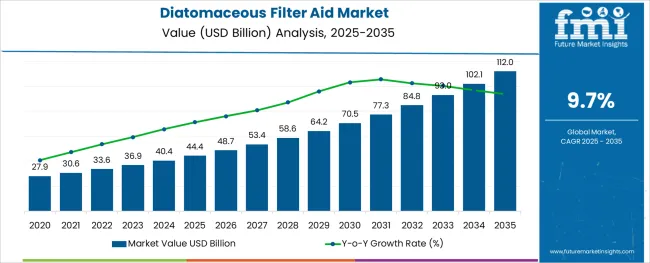
The diatomaceous filter aid market is growing steadily as food and beverage processors place greater emphasis on filtration quality and operational safety. Industry publications and product innovation updates have highlighted the increasing demand for natural filter aids that provide fine particle removal without altering product characteristics. The shift toward organic and minimally processed foods has driven interest in diatomaceous filter aids due to their natural composition and inert nature.
Manufacturers have optimized filtration processes by incorporating these aids to improve throughput and extend filter media life. Additionally, environmental concerns have encouraged industries to adopt filter aids that generate less waste and are easier to dispose of responsibly.
Looking ahead, market growth is anticipated to be shaped by evolving food safety regulations and the expanding scope of food applications where clear and contaminant-free products are essential. Segmental momentum is expected to be driven by Type II products due to their balance of filtration efficiency and permeability and the Dairy segment due to its consistent demand for high-clarity filtration processes.
The market is segmented by Type and Food Application and region. By Type, the market is divided into Type II and Type I. In terms of Food Application, the market is classified into Dairy, Bakery & Confectionery, Food Retail, Fruits & Vegetables, and Others. Regionally, the market is classified into North America, Latin America, Western Europe, Eastern Europe, Balkan & Baltic Countries, Russia & Belarus, Central Asia, East Asia, South Asia & Pacific, and the Middle East & Africa.
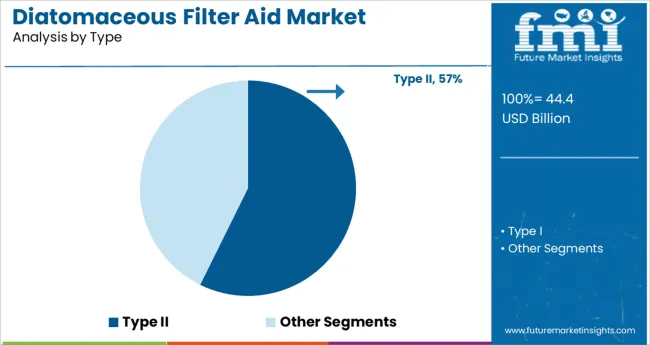
The Type II segment is projected to contribute 57.3% of the diatomaceous filter aid market revenue in 2025 sustaining its lead among product types. Growth of this segment is supported by the optimal particle size distribution of Type II filter aids which makes them suitable for balancing flow rate and filtration precision.
Industries have adopted Type II grades where maintaining clarity without significant flow restriction is critical. This filter type has gained traction in applications where fine particulate removal and filter cake stability are required to maintain product consistency.
The versatility of Type II filter aids across food and beverage filtration processes has further enhanced their usage. As filtration requirements continue to evolve toward achieving product purity and operational efficiency the Type II segment is expected to maintain steady demand in industrial filtration processes.
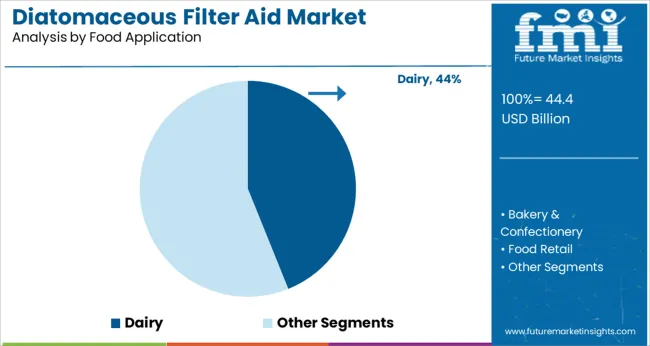
The Dairy segment is projected to account for 43.9% of the diatomaceous filter aid market revenue in 2025 maintaining its position as the leading food application. This growth has been shaped by the increasing need to remove microbial contaminants and suspended solids during dairy processing.
Dairy manufacturers have incorporated diatomaceous filter aids into their production lines to ensure the clarity and safety of milk whey and other liquid dairy products. Consistent consumer demand for high-quality dairy products has driven producers to invest in filtration solutions that enhance product shelf life and appearance.
Additionally, stringent hygiene standards in dairy processing have made filtration a critical control point in production facilities. As consumer preferences shift toward premium and functional dairy products the role of filtration in maintaining product integrity is expected to keep the Dairy segment at the forefront of filter aid applications.
High demand for effective filtration technologies, especially in food grade applications is anticipated to bolster the global diatomaceous filter aid market growth in the evaluation period. Increasing number of separation tasks in the food and beverage industry is mainly contributing to the growth.
Besides, filter aids are set to be used exponentially in the food industry owing to their ability to enhance the efficiency of the principal filtration apparatus. Governments of various countries are implementing stringent norms to maintain safety standards in food items, which is also likely to influence the market positively.
The easy availability of several substitute products in the market may hamper sales of diatomaceous filter aid in the assessment period. Also, high initial cost of these filter aids in the food industry is expected to hinder their installation in small-scale companies, especially in emerging economies.
In terms of region, Asia Pacific is projected to generate a lucrative diatomaceous filter aid market share during the forthcoming years. Ongoing expansion of the food and beverage sector in developing countries, such as India and China backed by the high demand for packaged food and rising number of health-conscious people is set to drive growth.
Increasing demand for cost-effective filtration solutions across the food industry is also estimated to aid growth. Manufacturers based in developing countries are thus striving to develop novel, yet low-cost products to help food companies keep up with quality-oriented standards.
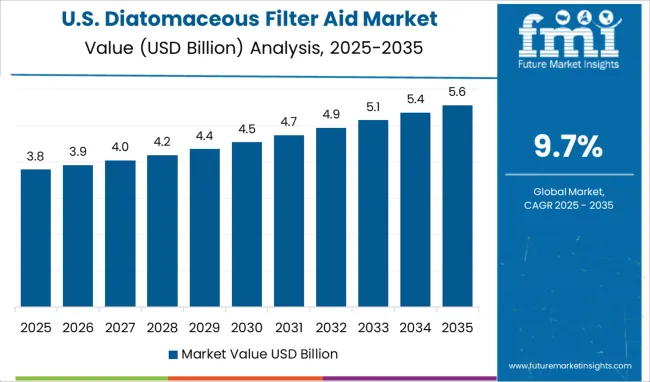
The imposition of stringent laws by government bodies to improve product quality is projected to encourage food companies to use novel filtration products across North America. Increasing awareness among consumers regarding the health benefits of clean label items is another factor that is expected to drive the demand for diatomaceous filter aid in the USA and Canada.
In addition, rising concerns for food safety and the need to lower product contagion caused during the manufacturing process by contamination are some of the other vital factors that would accelerate growth. Introduction of cutting-edge filtration systems by key players based in North America is also expected to boost the regional market.
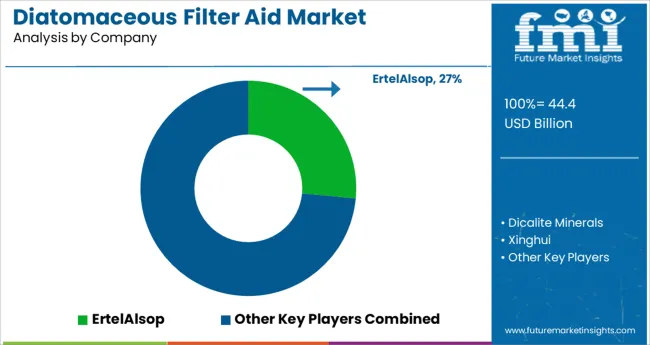
Some of the leading players operating in the global diatomaceous filter aid market include Pure Process, EP Minerals, Dicalite Management, ErtelAlsop, Jilin Yuan Tong Mineral, Dicalite Minerals, Shengzhou Huali Diatomite Products, and Xinghui among others.
Leading players are mainly focusing on coming up with lightweight offerings, which would help various food grade industry operators to lower their disposal costs. At the same time, they are aiming to provide density advantages in the existing portfolios, as compared to other products available in the market.
Meanwhile, some of the other manufacturers are striving to commercialize their products by realizing the significance of cost on decision-making of end-use industries. International players are vying to attain quality certifications to initiate their value proposition strategy and convince their clients to choose their in-house products over their competitors.
| Report Attribute | Details |
|---|---|
| Growth Rate | CAGR of 9.7% from 2025 to 2035 |
| Base Year for Estimation | 2024 |
| Historical Data | 2020 to 2024 |
| Forecast Period | 2025 to 2035 |
| Quantitative Units | Revenue in million and CAGR from 2025 to 2035 |
| Report Coverage | Revenue Forecast, Volume Forecast, Company Ranking, Competitive Landscape, Growth Factors, Trends and Pricing Analysis |
| Segments Covered |
Type, Food Application, Region |
| Regions Covered |
North America; Latin America; Western Europe; Eastern Europe; APEJ; Japan; Middle East and Africa |
| Key Countries Profiled | USA, Canada, Brazil, Argentina, Germany, UK, France, Spain, Italy, Nordics, BENELUX, Australia & New Zealand, China, India, ASEAN, GCC, South Africa |
| Key Companies Profiled |
Pure Process; EP Minerals; Dicalite Management; ErtelAlsop; Jilin Yuan Tong Mineral; Dicalite Minerals; Shengzhou Huali Diatomite Products; Xinghui |
| Customization | Available Upon Request |
The global diatomaceous filter aid market is estimated to be valued at USD 44.4 billion in 2025.
It is projected to reach USD 112.0 billion by 2035.
The market is expected to grow at a 9.7% CAGR between 2025 and 2035.
The key product types are type ii and type i.
dairy segment is expected to dominate with a 43.9% industry share in 2025.






Full Research Suite comprises of:
Market outlook & trends analysis
Interviews & case studies
Strategic recommendations
Vendor profiles & capabilities analysis
5-year forecasts
8 regions and 60+ country-level data splits
Market segment data splits
12 months of continuous data updates
DELIVERED AS:
PDF EXCEL ONLINE
Filter Bag Market Size and Share Forecast Outlook 2025 to 2035
Filter Press Solutions Market Size and Share Forecast Outlook 2025 to 2035
Filter Integrity Test Systems Market Size and Share Forecast Outlook 2025 to 2035
Filter Coatings Market Size and Share Forecast Outlook 2025 to 2035
Industry Share Analysis for Filter Paper Companies
Filter Paper Market Trends – Growth, Demand & Forecast through 2035
RF Filters Market Size and Share Forecast Outlook 2025 to 2035
SAW Filter Market Size and Share Forecast Outlook 2025 to 2035
Air Filters Market Growth - Trends & Forecast 2025 to 2035
Global Tea Filter Paper Market Analysis – Growth & Forecast 2024-2034
Spin Filters Market Size and Share Forecast Outlook 2025 to 2035
Wine Filtering Machine Market Expansion - Filtration & Winemaking Technology 2025 to 2035
Beer Filter System Market insights by Equipment Type, Type, Filtration Process, Application, and Region 2025 to 2035
EMI, Filter Kits Market
ePTFE Filter Film Market Size and Share Forecast Outlook 2025 to 2035
Coffee Filter Paper Market Size and Share Forecast Outlook 2025 to 2035
Fabric Filter System Market Size & Forecast 2025 to 2035
Market Share Distribution Among Coffee Filter Paper Manufacturers
TC-SAW Filter Market
Pleated Filters Market Size and Share Forecast Outlook 2025 to 2035

Thank you!
You will receive an email from our Business Development Manager. Please be sure to check your SPAM/JUNK folder too.
Chat With
MaRIA